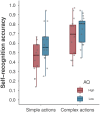The Impact of Autistic Traits on Self-Recognition of Body Movements
- PMID: 30687162
- PMCID: PMC6338035
- DOI: 10.3389/fpsyg.2018.02687
The Impact of Autistic Traits on Self-Recognition of Body Movements
Abstract
Despite the sparse visual information and paucity of self-identifying cues provided by point-light stimuli, as well as a dearth of experience in seeing our own-body movements, people can identify themselves solely based on the kinematics of body movements. The present study found converging evidence of this remarkable ability using a broad range of actions with whole-body movements. In addition, we found that individuals with a high degree of autistic traits showed worse performance in identifying own-body movements, particularly for simple actions. A Bayesian analysis showed that action complexity modulates the relationship between autistic traits and self-recognition performance. These findings reveal the impact of autistic traits on the ability to represent and recognize own-body movements.
Keywords: autism-spectrum quotient; biological motion; body movements; self-recognition; visual perception.
Figures





Similar articles
-
Individual differences and motor planning influence self-recognition of actions.PLoS One. 2024 Jul 30;19(7):e0303820. doi: 10.1371/journal.pone.0303820. eCollection 2024. PLoS One. 2024. PMID: 39078856 Free PMC article.
-
Individual differences in high-level biological motion tasks correlate with autistic traits.Vision Res. 2017 Dec;141:136-144. doi: 10.1016/j.visres.2016.11.005. Epub 2016 Dec 18. Vision Res. 2017. PMID: 27919678
-
Differences in the production and perception of communicative kinematics in autism.Autism Res. 2021 Dec;14(12):2640-2653. doi: 10.1002/aur.2611. Epub 2021 Sep 18. Autism Res. 2021. PMID: 34536063 Free PMC article.
-
Viewpoint and the recognition of people from their movements.J Exp Psychol Hum Percept Perform. 2009 Feb;35(1):39-49. doi: 10.1037/a0012728. J Exp Psychol Hum Percept Perform. 2009. PMID: 19170469
-
Autistic traits are linked to reduced adaptive coding of face identity and selectively poorer face recognition in men but not women.Neuropsychologia. 2013 Nov;51(13):2702-8. doi: 10.1016/j.neuropsychologia.2013.08.016. Epub 2013 Aug 29. Neuropsychologia. 2013. PMID: 23994355
Cited by
-
Self-Awareness from Whole-Body Movements.J Neurosci. 2025 Jan 15;45(3):e0478242024. doi: 10.1523/JNEUROSCI.0478-24.2024. J Neurosci. 2025. PMID: 39496486 Free PMC article.
-
Neural Mechanisms of Visual Motion Anomalies in Autism: A Two-Decade Update and Novel Aetiology.Front Neurosci. 2021 Nov 1;15:756841. doi: 10.3389/fnins.2021.756841. eCollection 2021. Front Neurosci. 2021. PMID: 34790092 Free PMC article. Review.
-
Ties between reading faces, bodies, eyes, and autistic traits.Front Neurosci. 2022 Sep 28;16:997263. doi: 10.3389/fnins.2022.997263. eCollection 2022. Front Neurosci. 2022. PMID: 36248653 Free PMC article.
-
Innovative Digital Phenotyping Method to Assess Body Representations in Autistic Adults: A Perspective on Multisensor Evaluation.Sensors (Basel). 2024 Oct 10;24(20):6523. doi: 10.3390/s24206523. Sensors (Basel). 2024. PMID: 39460004 Free PMC article.
-
Individual differences and motor planning influence self-recognition of actions.PLoS One. 2024 Jul 30;19(7):e0303820. doi: 10.1371/journal.pone.0303820. eCollection 2024. PLoS One. 2024. PMID: 39078856 Free PMC article.
References
LinkOut - more resources
Full Text Sources

